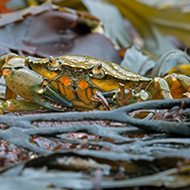
Invasive crayfish and crabs had the highest costs.
The global economic costs of invasive aquatic crustaceans amounted to at least $271 million over recent years, according to new research.
Invasive crustacean species are proven to pose a severe threat to ecosystems, with crayfish and crabs understood to be the most damaging because of their size, pivotal role in ecosystems and tolerance to different environments.
While invasive crustaceans and their impact on the environment have received greater attention in recent years, the economic impact has gone largely unnoticed. In this latest study, an international team of researchers compiled all existing published costs of invasive aquatic crustaceans.
Commenting on the findings, Dr Oficialdegui, a postdoctoral researcher from Doñana Biological Station in Seville, Spain, said: “The global economic costs of invasive aquatic crustaceans amounted to at least $271 million. That is approximately one euro for every citizen from Germany, France, Italy and Spain needed to pay for the damage caused by invasive crustaceans, and even that is a massive underestimation of the real costs.”
The results of the study show that crayfish-related costs were mainly attributed to Sweden at US$ 116.4 million.
North American crayfish species, such as the rusty crayfish, red swamp crayfish and spiny-cheek crayfish also had economic costs but were reported to a lesser extent. Around 80 per cent of crayfish-related costs were attributed to damages or resource losses, such as agriculture and fishing.
Another finding was that invasive crabs caused monetary costs mostly to North America and Europe, mainly as a consequence of the European green crab and the Chinese mitten crab. These invasions mainly affected fisheries, authorities and stakeholders, with the vast majority of them related to damages and losses to resources.
Dr Kouba, Associate Professor at the University of South Bohemia in České Budějovice in the Czech Republic, said: “Surprisingly, only a few costs were allocated to the management (prevention, control, mitigation or eradication) of these invasive crustaceans.
“One of the causes of these knowledge gaps could be the benefits (commercial and recreational) provided, contributing to a higher perceived value of these invasive species. This, in some ways, may lead to limited recognition of costs (especially indirect costs), as well as limited interest in understanding impacts needed to prevent and control future and current invasions.”
Looking ahead, the team believe that the high levels of damage costs show that greater management is urgently needed to prevent and control future and current invasions.
Study co-lead author Dr Cuthbert, from Queen's University Belfast, said: “Although a great deal of effort has been made to compile costs of invasive crustaceans, the gaps in reported costs at taxonomic (many known invaders have no reported costs), geographic (Asia, Africa, South America or Oceania are virtually absent), and temporal scales (most costs occurred in the 21st century) suggest that the monetary costs reported here are highly underestimated.”
"This highlights the need for further reporting of costs in these taxonomic groups to assess better the true magnitude of the monetary costs caused by invasive crustaceans, as many costs have not yet been quantified and published.”



 BSAVA is to partner with BVA Live (11-12 June 2026) to champion clinical research.
BSAVA is to partner with BVA Live (11-12 June 2026) to champion clinical research.